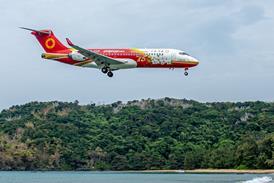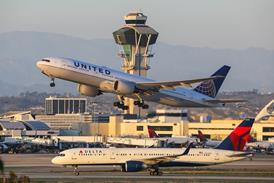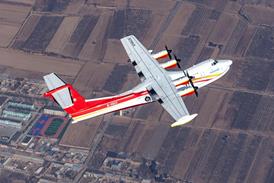Paul Lewis/SEATTLE
AIRLINE PRESSURE has forced Boeing to increase the range of its proposed 747-600X. The move is one of several changes in baseline performance which the Seattle-based manufacturer is considering for the 747X programme following input received from potential customers.
Design range has been increased to 14,060km (7,600nm). The airlines had argued that the original 13,320km range provided no advantage over the 747-400, which is limited on payload for non-stop flights between destinations such as Hong Kong and Los Angeles. The maximum take-off weight of the larger -600X version has been raised to 513,000kg, according to sources.
The 45,500kg weight increase provides for the additional fuel needed to extend the -600X's maximum range by a further 740km, to 14,060km.
Boeing, meanwhile, is discussing the signing of a memorandum of understanding with a group of potential 747-500/600X launch customers, to provide a more detailed definition of the proposed growth derivatives.
The US manufacturer is being pressed by its group of 17 advisory airlines to provide more specific data on the proposed aircraft's operating economics. Boeing, in turn, is looking for greater airline commitment to the project before it will provide additional funding for a definition study.
The -600X is planned to carry 520 passengers in a typical three-class layout, compared to 412 in the -400. The aircraft's 85m fuselage length is meeting some resistance from airport planners, but airlines argue that any reduction in the size of the airframe will push up seat-kilometre costs.
A report from the Airports Council International (ACI) estimates that airports will need an average $100 million investment to upgrade to cope with aircraft such as the 747X and Airbus A3XX.
A review of 32 major airports by the ACI reveals they could actually lose capacity because of the constraints arising from large-aircraft operations, such as the effect of wake turbulence.
Upgrade costs vary widely, says the ACI, but come out at an average of $16 million per large-aircraft gate for newer airports such as Amsterdam Schiphol and Tokyo Haneda. Older airports, such as London Heathrow, or New York Kennedy, would have to spend up to $360 million.
Extending the aircraft's range has also allowed a consensus to be reached among the airlines on developing the -600X version first. The group had been split previously, with some carriers pushing for the smaller, longer-range, -500X aircraft to lead instead. Slightly larger than the 747-400, the -500X will be able to carry around 440 passengers (three-class) over a distances of about 15,200km.
The 747-600X is now tentatively scheduled to enter service in December 2000, with the -500 following 12 months later.
Source: Flight International


























